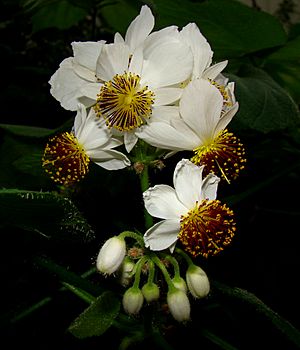Henderina Scott facts for kids
Henderina Victoria Scott (born July 18, 1862, died January 18, 1929) was an amazing English scientist who studied plants. She was one of the first people to use a special camera trick called time-lapse photography to watch plants grow and move.
Quick facts for kids
Henderina Victoria Scott
|
|
|---|---|
| Born |
Henderina Victoria Klaassen
18 July 1862 Brixton, London
|
| Died | 18 January 1929 (aged 66) East Oakley House, Basingstoke, Hampshire
|
| Nationality | British |
| Alma mater | Royal College of Science, 1887 |
| Known for | Use of cinematography to research plant growth and movement |
| Spouse(s) | Dukinfield Henry Scott (1854–1934) |
| Children | 7 |
| Awards | Fellow of the Linnean Society of London (1905) |
Early Life and Learning
Henderina Victoria Klaassen was born in London in 1862. Her dad, Hendericus M. Klaassen, came from Germany. He was a successful businessman. He loved science, especially rocks and the Earth (geology). Henderina and her sister Helen were interested in science from a young age.
In 1886, Henderina studied plants (botany) at the Royal College of Science. There, she met Dukinfield Henry Scott, who taught advanced plant classes. They got married in 1887. Henderina helped her husband with his work. She also did her own important plant research. She did not have a teaching job at a university.
Amazing Plant Research
Henderina Scott helped her husband with his studies. For example, she organized his collections of old plant slides. She also drew pictures for his science books. But she also did her own special research on plants. She even studied very old plants (paleobotany).
Her most exciting work was using cameras to record how plants grow. This was a new idea! She used a special type of filming called time-lapse photography. This makes slow changes look fast. She used it to show how the flowers of Sparmannia africana move. This plant is also called African linden or African hemp.
Scientists already knew that parts of the flower, called stamens, could move. But Henderina showed that the petals, sepals, and even the whole flower bud could move quickly too. These flowers lived longer in greenhouses in the UK than in their warm home in South Africa.
To record these movements, she made drawings. But she also used a special camera called a Kammatograph. This camera took pictures on a glass disc. You could then show these pictures like a movie using a magic lantern. This was around the year 1900. The company that made the Kammatograph helped her make it perfect for her time-lapse studies. Some of her photos were put into her science papers. Sadly, none of her original film discs have survived today.
Her other slow-motion time-lapse films showed many plant actions. These included buds opening and a bee helping with pollination. She also filmed a new shoot opening. She did this work much earlier than other famous time-lapse photographers.
Henderina showed her time-lapse films at many science meetings. These included a special event at the Royal Society in 1904. She also showed them at the British Association for the Advancement of Science. In 1905, she showed them at the Linnean Society in London. This was after she became a Fellow of the society. She continued her research even after her family moved from London.
Personal Life
Henderina and her husband had seven children. Sadly, one died as a baby. Only four of their children lived to be adults. In 1907, she and her husband moved to East Oakley House. This was near Basingstoke in Hampshire. There, Henderina became involved in local schools and community decisions. She also welcomed many scientists from other countries to their home. She passed away at home on January 18, 1929. Her death was unexpected after a short illness.


